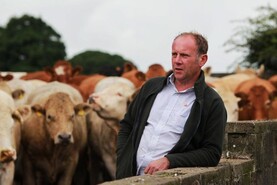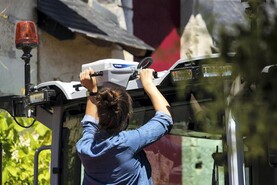I was in McCormack’s workshop chatting with the two lads and Bruno appears. “See that big auld Yankee Doodle Dandy John Deere over there,” he grunts, pointing to a nice 1993 model 4955 (in for a hitch refit).
“The bonnet badge is different to a modern John Deere. The deer is running on that badge but he’s like a buckin’ racehorse clearing a fence on my tractors. Come over here and I’ll you show what I mean.”
“Do we have to Bruno?” I ask, suddenly overcome by nausea with the sickly thought of such massive John Deere exposure. I’d rather be exposed going al fresco behind Bruno’s digger than that.
Anyhow we walked over to Bruno’s machinery shed which is jammed with green machinery. There were five shining tractors and McHale and Krone machinery. One tractor is actually an ‘ancient’ 6195 from 2016 – it’s the oldest by far. I could see the point Bruno was making about the Deere logo (I Googled it since, “the Bambi” logo changed in 2000). But strange as this may seem, I was actually now feeling good in myself among all these Bambi tractors.
You see, as it happens, I’m thinking of buying one new tractor and selling two, a 1997 model 816 and a 2009 model 718. I’ve already sold the 816. So, the plan is just two tractors, a 2018 Fendt 724 and a new 720. Maybe.
I’d still be out an awful lot of money but it struck me that perhaps I should follow Bruno’s example and just do it. I admire him for that.
But in the midst of all this shiny green technology was a beautifully restored 1973 Massey Ferguson 148. I asked Bruno would he sell it but no, he wouldn’t. Now it’s a bit rich coming from someone like me who has never owned an MF (or my father before me) but I often think we never make enough of Irishman Harry Ferguson.
Ferguson was born 140 years ago in 1884 on a Co Down farm. Tractors were really only coming into larger farms during World War I when men and horses were scarce. In 1917, there were just 70 tractors on Irish farms but, by 1918, it had escalated to 640. Many of these early American tractors were big and heavy and not designed for smaller farms and needed the space of a 25ac field to chug around with a trailed plough.
Ferguson was very aware of these shortcomings. He developed lightweight tractors for smaller farms culminating in the 1946 little grey Fergie (the TE20, of which 517,000 were built) with its three-point linkage and draft control.
This increased traction to equal that of a heavier tractor. Patented as the Ferguson System, a modernised version is still used today on 85% of tractors worldwide.
Ferguson was also a pioneer in the motoring world. He developed the world’s first automotive 4WD system and anti-lock brakes which he saw as paramount to road safety. But for all of that, Harry Ferguson was a difficult and deep-thinking man who died in sad circumstances on 25 October 1960.
My grandfather died just three days later but they probably ignored each other at the pearly gates as grandfather was a Ford(son) man. Henry and Harry had long fallen out over that handshake agreement. Tricky things, handshakes.
So, you’d think after all this hero worship, I’d be buying a Massey Ferguson tractor. I should be but I’m incapable of a brand change at this stage in my life – it’d spark another midlife crisis.
The Fendt that I fancy has 10 times the horsepower of the little grey Fergie. That’s good but the problem is it’s 650 times the price. It’s too much – perhaps I didn’t spend long enough in Bruno’s shed.






 This is a subscriber-only article
This is a subscriber-only article










SHARING OPTIONS: